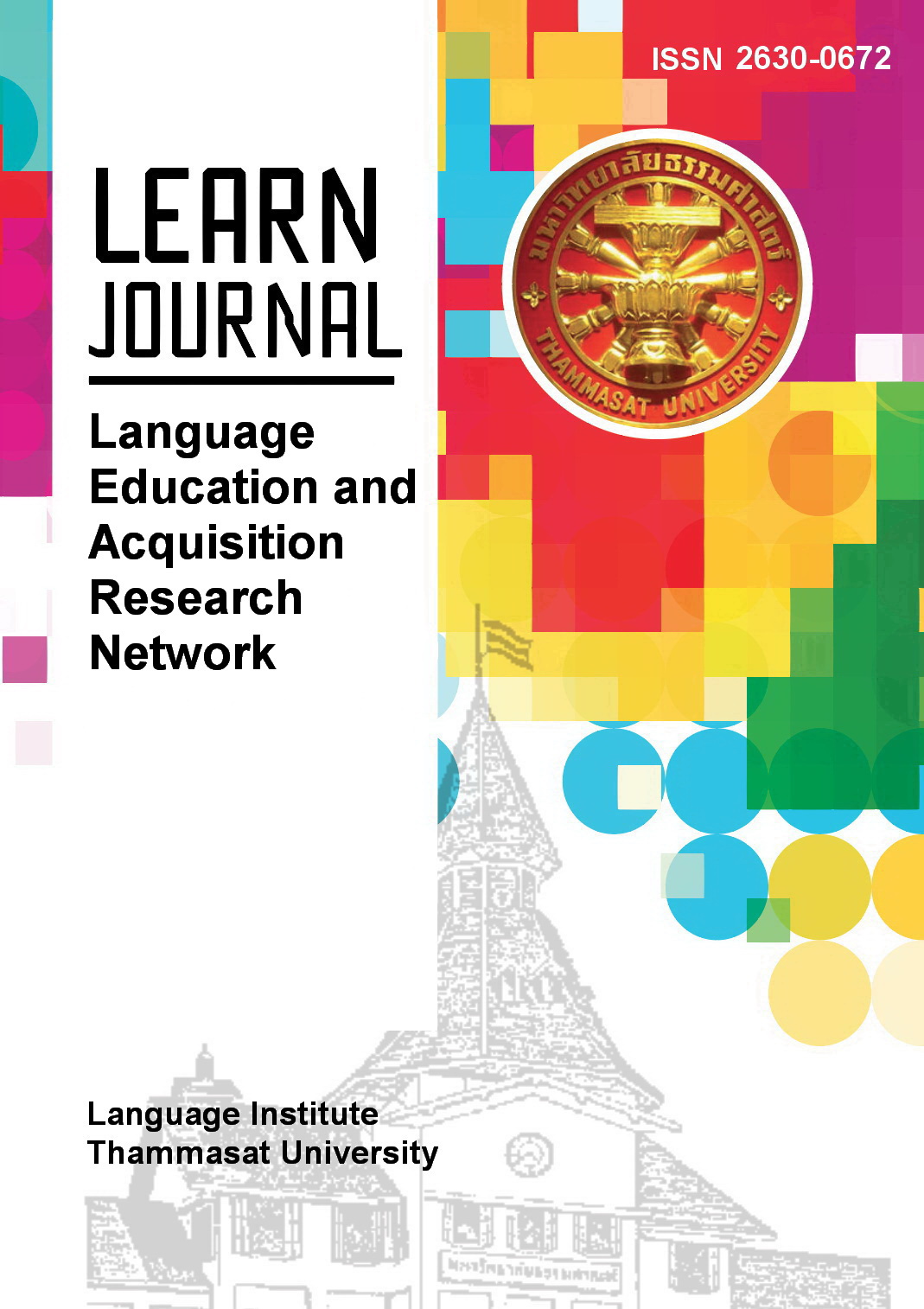Usability and motivation study of mobile application for English language proficiency test preparation in Thailand: A case study of TU-GET CBT
Main Article Content
Abstract
Usability testing is a method that determines how user-friendly a website or a mobile application is. The present study investigated the usability of a newly launched mobile application called TU-GET CBT or Thammasat University General English Test (Computer-Based Test). It also strived to understand the extent to which the application contributes to users’ motivation. Twenty-one target users were involved in three focus group sessions; they also completed a usability and intrinsic motivation questionnaire. In addition, five experts in the field of language education and technology performed the heuristic evaluation that measured the application’s usability. The findings showed that in general, all participants were satisfied with the application in terms of its usefulness for English language learning and test preparation. Nonetheless, several technical usability issues were identified including accessibility, navigability, and aesthetics. Pedagogical usability of consistency and feedback were also raised across findings. In regard to motivation, the findings suggested that the users’ motivation can increase if they perceive the application as valuable and enjoyable. These findings provide valuable implications for the next phase of the TU-GET CBT application development.
Article Details
References
Botero, G. G., Questier, F. & Zhu, C. (2019). Self-directed language learning in a mobile-assisted, out-of-class context: Do students walk the talk? Computer Assisted Language Learning, 32(1-2), 71-97. DOI: 10.1080/09588221.2018.1485707
Carrera, C. C., Perez, J. L. S., & Cantero, J. T. (2018). Teaching with AR as a tool for relief visualization: Usability and motivation study. International Research in Geographical and Environmental Education, 27(1). https://doi.org/10.1080/10382046.2017.1285135
Elaish, M. M., Shuib, L., Ghani, N. A., Yadegaridehkordi, E. & Alaa, M. (2017). Mobile learning for English language acquisition: Taxonomy, challenges, and recommendations. IEEE Access, 5, 19033-19047. DOI: 10.1109/ACCESS.2017.2749541
Georgsson, M. & Staggers, N. (2015). Quantifying usability: An evaluation of a diabetes mHealth system on effectiveness, efficiency, and satisfaction metrics with associated user characteristics. Journal of the American Medical Informatics Association, 23(1), 5-11. DOI: 10.1093/jamia/ocv099
Godwin-Jones, R. (2017). Smartphones and language learning. Language, Learning and Technology, 21(2), 3-17. Retrieved from http://llt.msu.edu/issues/june2017/emerging.pdf
Hadjerrouit, S. (2012). Investigating Technical and Pedagogical Usability Issues of Collaborative Learning with Wikis. Informatics in Education, 11(1), 45–64.
Hoehle, H. & Venkatesh, V. (2015). Mobile application usability: Conceptualization and instrument development. MIS Quarterly, 39(2), 435-472.
Kukulska-Hulme, A. (2009). Will mobile learning change language learning? ReCALL, 21(2), 157–165. DOI: 10.1017/S0958344009000202
Kukulska-Hulme, A. (2018). Mobile-assisted language learning [Revised and updated version]. In A. C. Chapelle (Ed.), The encyclopedia of applied linguistics. Wiley. https://doi.org/10.1002/9781405198431.wbeal0768
Lestary, S. (2020). Perceptions and experiences of mobile-assisted language learning for IELTS preparation: A case study of Indonesian learners. International Journal of Information and Education Technology, 10(1), 67-73. DOI: 10.18178/ijiet.2020.10.1.1341
Lewis, J. R. (2002). Psychometric evaluation of the PSSUQ using data from five years of usability studies. International Journal of Human-Computer Interaction, 14(3-4), 463-488. doi: 10.1080/10447318.2002.9669130
Nielson, J. (1994, April 24). 10 usability heuristics for user interface design. Nielsen Norman Group. https://www.nngroup.com/articles/ten-usability-heuristics/
Nielsen, J., & Molich, R. (1990). Heuristic evaluation of user interfaces. Paper presented at the Proceedings of the SIGCHI Conference on Human Factors in Computing Systems, 249-256. https://doi.org/10.1145/97243.97281
Nokelainen, P. (2006). An empirical assessment of pedagogical usability criteria for digital learning material with elementary school students. Journal of Educational Technology & Society, 9(2), 178-197. https://www.jstor.org/stable/10.2307/jeductechsoci.9.2.178
Saritepeci, M., Duran, A. & Ermis, U. F. (2019). A new trend in preparing for foreign language exam (YDS) in Turkey: Case of WhatsApp in mobile learning. Education and Information Technologies, 24, 2677-2699. https://doi.org/10.1007/s10639-019-09893-4
Schlatter, T. & Levison, D. (2013). Visual usability: Principles and practices for designing digital applications. Morgan Kaufmann.
Tsourounis, S. & Demmans Epp, C. (2016). Learning dashboards and gamification in MALL: Design guidelines in practice. In A. P. Palalas, M. Allies (Eds), The international handbook of mobile-assisted language learning (pp. 370–398). China Central Radio & TV University Press Co., Ltd.
Underwood, J. (2014). Using iPads to help teens design their own activities. In S. Jager, L. Bradley, E. J. Meima, & S. Thouësny (Eds.), CALL Design: Principles and Practice. Proceedings of the 2014 EUROCALL Conference, Groningen, The Netherlands (pp. 385-390). Dublin: Research-publishing.net. DOI:10.14705/rpnet.2014.000250
Zaharias, P. & Poylymenakou, A. (2009). Developing a usability evaluation method for e-learning applications: Beyond functional usability. International Journal of Human–Computer Interaction, 25(1), 75-98. doi: 10.1080/10447310802546716


